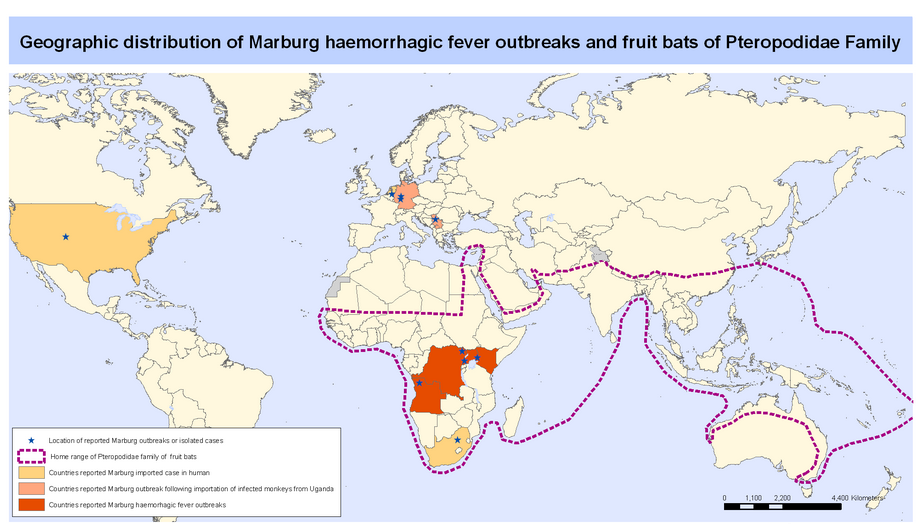Marburg hemorrhagic fever epidemiology and demographics
|
Marburg hemorrhagic fever Microchapters |
|
Differentiating Marburg hemorrhagic fever from other Diseases |
|---|
|
Diagnosis |
|
Treatment |
|
Case Studies |
|
Marburg hemorrhagic fever epidemiology and demographics On the Web |
|
American Roentgen Ray Society Images of Marburg hemorrhagic fever epidemiology and demographics |
|
FDA on Marburg hemorrhagic fever epidemiology and demographics |
|
CDC on Marburg hemorrhagic fever epidemiology and demographics |
|
Marburg hemorrhagic fever epidemiology and demographics in the news |
|
Blogs on Marburg hemorrhagic fever epidemiology and demographics |
|
Risk calculators and risk factors for Marburg hemorrhagic fever epidemiology and demographics |
Editor-In-Chief: C. Michael Gibson, M.S., M.D. [1] ; Associate Editor(s)-in-Chief: Aditya Ganti M.B.B.S. [2]
Overview
Recorded cases of Marburg hemorrhagic fever disease are rare. The first documented outbreak of marburg hemorrhagic fever occurred in 1967 in Marburg and Frankfurt, Germany and in Belgrade. Case fatality rates in marburg hemorrhagic fever outbreaks have ranged from 23% to 90%. Marburg hemorrhagic fever commonly affects younger individuals less than 5 years old and adults >50 years old compared to normal age groups.
Epidemiology
Incidence and Prevalence
- Recorded cases of Marburg hemorrhagic fever disease are rare. Hence it is difficult to obtain accurate data of incidence and prevalence of Marburg hemorrhagic fever.
Outbreak
- The first documented outbreak of marburg hemorrhagic fever occurred in 1967 in Marburg and Frankfurt, Germany and in Belgrade (in the former Yugoslavia) among laboratory workers exposed to blood and tissue products of African green monkeys imported from Uganda.
- Secondary transmission to medical staff and family members was also documented.[1][2]
- In total, 31 patients became infected, and 7 of these patients died.[3]
- During the next 2 decades, Marburg hemorrhagic fever was associated with sporadic, isolated, usually fatal cases among residents and travelers in southeast Africa.
- In 1998 to 2000, there was a prolonged outbreak involving 154 cases of Marburg hemorrhagic fever in Durba, Democratic Republic of the Congo (DRC) that was associated with individuals working in an underground gold mine.
- The largest and most lethal Marburg virus outbreak to date occurred in 2004 to 2005 in northern Angola.[4]
- This outbreak involved 252 cases, with a case-fatality rate of 90%.
- Between 2007 and 2012, several small episodes of Marburg hemorrhagic fever were reported in Uganda, with one case being exported to the United States and one to the Netherlands.
- In October 2014, a single case of Marburg hemorrhagic fever was reported in Uganda.
Case fatality rate
- Case fatality rates in marburg hemorrhagic fever outbreaks have ranged from 23% to 90%.
Demographics
Age
- Patients of all age groups may develop marburg hemorrhagic fever.
- Marburg hemorrhagic fever commonly affects younger individuals less than 5 years old and adults >50 years old compared to normal age groups.
Race
There is no racial predilection to marburg hemorrhagic fever.
Gender
Marburg hemorrhagic fever affects men and women equally.
Geographic Distribution

References
- ↑ Martini GA (1973). "Marburg virus disease". Postgrad Med J. 49 (574): 542–6. PMC 2495590. PMID 4207635.
- ↑ Brauburger K, Hume AJ, Mühlberger E, Olejnik J (2012). "Forty-five years of Marburg virus research". Viruses. 4 (10): 1878–927. doi:10.3390/v4101878. PMC 3497034. PMID 23202446.
- ↑ Conrad JL, Isaacson M, Smith EB, Wulff H, Crees M, Geldenhuys P, Johnston J (1978). "Epidemiologic investigation of Marburg virus disease, Southern Africa, 1975". Am. J. Trop. Med. Hyg. 27 (6): 1210–5. PMID 569445.
- ↑ Towner JS, Khristova ML, Sealy TK, Vincent MJ, Erickson BR, Bawiec DA, Hartman AL, Comer JA, Zaki SR, Ströher U, Gomes da Silva F, del Castillo F, Rollin PE, Ksiazek TG, Nichol ST (2006). "Marburgvirus genomics and association with a large hemorrhagic fever outbreak in Angola". J. Virol. 80 (13): 6497–516. doi:10.1128/JVI.00069-06. PMC 1488971. PMID 16775337.
- ↑ "World Health Organization".